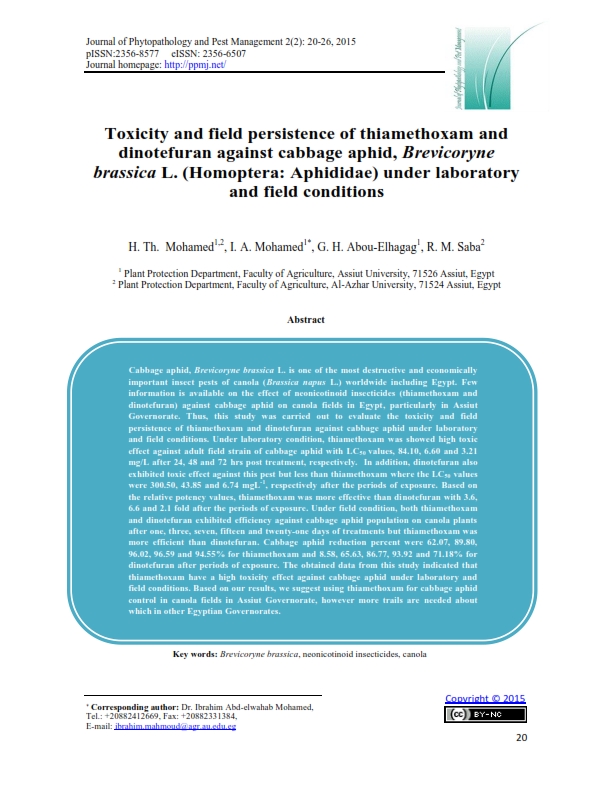Toxicity and field persistence of thiamethoxam and dinotefuran against cabbage aphid, Brevicoryne brassica L. (Homoptera: Aphididae) under laboratory and field conditions
Keywords:
Brevicoryne brassica, neonicotinoid insecticides, canolaAbstract
Cabbage aphid, Brevicoryne brassica L. is one of the most destructive and economically important insect pests of canola (Brassica napus L.) worldwide including Egypt. Few information is available on the effect of neonicotinoid insecticides (thiamethoxam and dinotefuran) against cabbage aphid on canola fields in Egypt, particularly in Assiut Governorate. Thus, this study was carried out to evaluate the toxicity and field persistence of thiamethoxam and dinotefuran against cabbage aphid under laboratory and field conditions. Under laboratory condition, thiamethoxam was showed high toxic effect against adult field strain of cabbage aphid with LC50 values, 84.10, 6.60 and 3.21 mg/L after 24, 48 and 72 hrs post treatment, respectively. In addition, dinotefuran also exhibited toxic effect against this pest but less than thiamethoxam where the LC50 values were 300.50, 43.85 and 6.74 mgL-1, respectively after the periods of exposure. Based on the relative potency values, thiamethoxam was more effective than dinotefuran with 3.6, 6.6 and 2.1 fold after the periods of exposure. Under field condition, both thiamethoxam and dinotefuran exhibited efficiency against cabbage aphid population on canola plants after one, three, seven, fifteen and twenty-one days of treatments but thiamethoxam was more efficient than dinotefuran. Cabbage aphid reduction percent were 62.07, 89.80, 96.02, 96.59 and 94.55% for thiamethoxam and 8.58, 65.63, 86.77, 93.92 and 71.18% for dinotefuran after periods of exposure. The obtained data from this study indicated that thiamethoxam have a high toxicity effect against cabbage aphid under laboratory and field conditions. Based on our results, we suggest using thiamethoxam for cabbage aphid control in canola fields in Assiut Governorate, however more trails are needed about which in other Egyptian Governorates.
Metrics

Published
How to Cite
Issue
Section
License
Authors who publish with Journal of Phytopathology and Disease Management agree to the following terms:
- Authors retain copyright and grant the journal right of first publication with the work simultaneously licensed under a Creative Commons Attribution License that allows others to share the work with an acknowledgement of the work's authorship and initial publication in this journal.
- Authors retain copyright and grant the journal right of first publication with the work simultaneously licensed under the Creative Commons Attribution-Non Commercial License (CC BY-NC). This allows others to share the work with an acknowledgement of the work's authorship and initial publication in this journal.
- Archives of Agricultural Sciences Journal is an Open Access Journal, and articles published are distributed under the terms of the Creative Commons Attribution-Non Commercial License (CC BY-NC). Readers may copy, distribute, and display the work for non commercial purposes with the proper citation of the original work. However, the journal retains the right to exploit subsidiary rights on behalf of the authors.
- Authors are able to enter into separate, additional contractural arrangements for the non-exclusive distribution of the journal's published version of the work (e.g. post it to an institutional repository or publish it in a book), with an acknowledgement of its initial publication in this journal.
- Authors are permitted and encouraged to post their work online (e.g., in institutional repositories or on their website) prior to and during the submission process with full disclosure to the journal, as it can lead to productive exchanges, as well as earlier and greater citation of published work. Following publication in Archives of Agricultural Sciences Journal, the author should update the repository, and include a citation and link to the published work.
Click here for more information on Licensing policy
.png)




